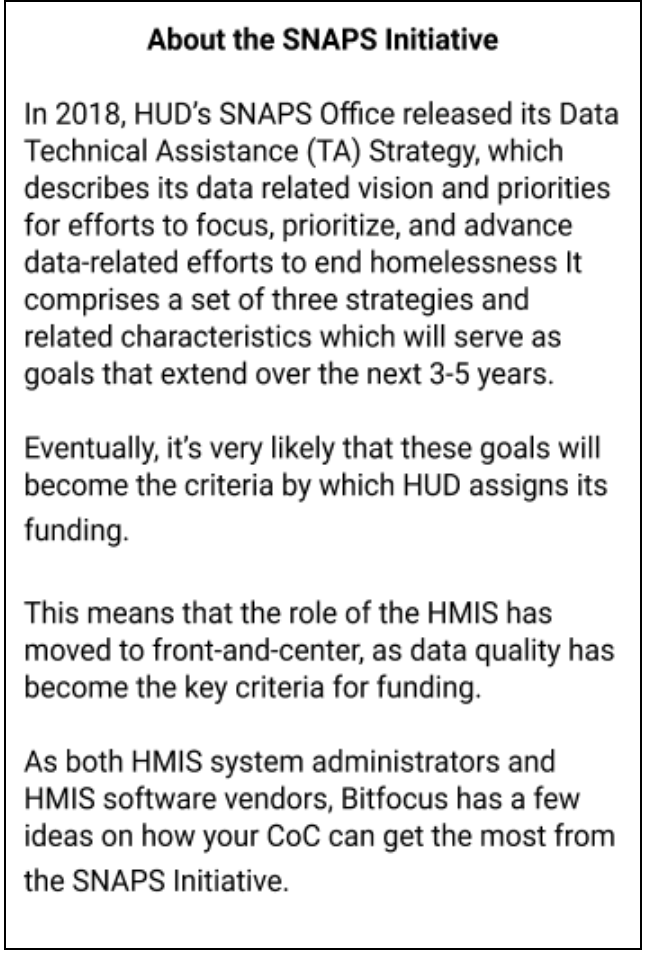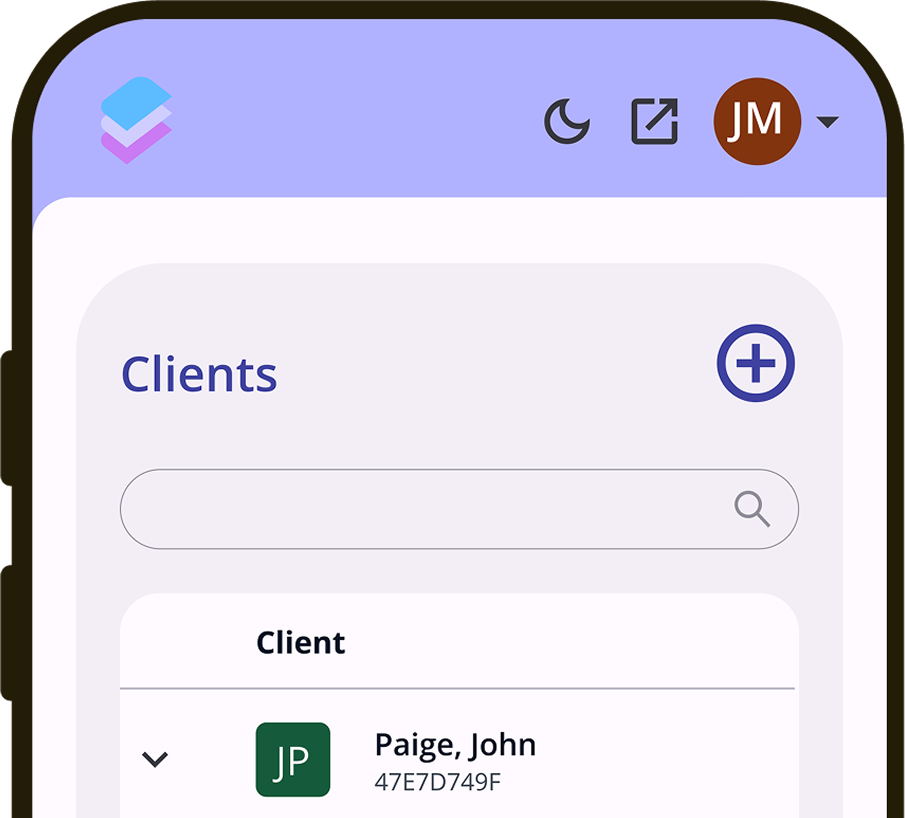What You Need to Know About the HUD SNAPS Initiative
/solutions-hmis/solutions-hmis-bg.jpg)
— And How Bitfocus Can Help.
This is the first article of a four-part series going into the most recent HUD SNAPS initiative strategies and what it looks like for communities to achieve an advanced level of implementation for each strategy. In this article, we’ll talk about how the role of HMIS has moved to front-and-center, as data quality has become the key criteria for funding.

The relationship between data and homelessness is simple — HMIS data is the driving force for integrated and coordinated systems of care. If equipped with a powerful HMIS, CoCs can go well beyond simply measuring the scope of the problem; they can use the data to detect trends among various subpopulations, identify common antecedents of episodes of homelessness, and measure the performance of their approaches and strategies.
In recent years, HUD has paid increasing attention to this fact, and, as a result, has been continuously raising the bar of expectations for CoCs in regards to data efforts. With each annual NOFA, the allocation of funding is further refined and distributed according to data quality and the results that this data shows.

Over time, HUD has realized that the implementation of data-driven strategies is not as simple as it initially seemed. CoCs face many barriers to developing a data-focused culture — such as inadequate training, lack of personnel, political conflicts, and software limitations — and they need smarter forms of assistance.
HUD most recently rolled out an ambitious agenda for broadening the umbrella of support they offer to CoCs. Through the Special Needs Assistance Program (SNAPS), HUD is answering these concerns with a fresh strategy and a goodie-bag full of opportunities and technical assistance. This new strategy aims to help communities base more of their decisions on outcome and performance measures. Perhaps more importantly, however, the SNAPS initiative sets the official standards and expectations for HUD’s vision (and, not to mention, their future funding requirements) for data-driven organizations. Put simply: they’re using this strategy to define their relationship with CoCs for the foreseeable future.
The role of the HMIS has moved to front-and-center,
as data quality has become the key criteria for funding.
Therefore, there are many exciting funding opportunities on the horizon for communities who familiarize themselves with this SNAPS initiative and explore the broader capabilities of their Homeless Management Information System (HMIS).
In short, the SNAPS initiative is game-changing.
How Bitfocus Aims to Help
Purpose Driven Development
As HMIS System Administrators, Bitfocus is dedicated to purpose-driven development, from both a software standpoint and from the broader standpoint of company development. Every element of our strategy — from software development, customer support, to staff recruitment, and even business development — is driven by the underlying belief that we think data is the key solution to ending homelessness and tackling the momentous social challenges that we are all facing together. As such, Bitfocus wants to place vendor partisanship aside, and ensure that all communities benefit from every opportunity the SNAPS Initiative provides.

In this series of articles, we’re sharing some of the exciting things that Bitfocus’ communities are doing to meet the requirements of the SNAPS Initiative. Hopefully, these examples will spark ideas that you can use to pilot your own CoC toward higher levels of excellence.
As you’ll see, our dedication to purpose-driven development has pushed Bitfocus CoC customers to the forefront, and they are fully prepared to fulfill HUD’s long-term vision.
In fact, most already have.
We want to show why our communities are so well prepared, and how you can be too.
The New SNAPS-TA Initiative
The Goals
HUD has identified three primary data-related goals for CoCs nationwide:
- DATA-INFORMED DECISION MAKING: For all partners in a CoC to make better use of data when improving their system’s performance and when deciding where to allocate resources.
- BUILDING A HIGH FUNCTIONING SYSTEM: For all partners in a CoC to use data software (HMIS) that enables “accurate, comprehensive and timely data collection, usage and reporting.”
- CROSS-AGENCY COLLABORATION: For Federal agencies to better coordinate data-sharing practices, data-usage, and data-informed policy development between and within organizations.
These three pillars are incredibly important. HUD treats these as goals, yes, but they also plan to use them as criteria for evaluating which communities get the most assistance (i.e., funding). So, it’s in your best interest to pay close attention to them, and to this initiative as a whole.
HUD’s strategy for reaching these goals
At first glance, HUD’s SNAPS initiative might seem similar to previous initiatives. Yet, its scope is broader and more detailed than anything HUD has outlined for HMIS before.
HUD has created a three-part strategy to bring every homeless-assistance organization into harmony with its data vision. These are:
- Developing the capability of communities to install, use, and benefit from HMIS
- For HMIS users to gather accurate, extensive, and timely data
- For CoCs and their partners to consistently use data analysis to guide and enhance their efforts to end homelessness
For each part of this strategy, HUD lays out a 3–5 year plan, which it further divides into objectives for “the majority of CoCs” and “Advanced CoCs”.
Next, in the upcoming articles within this HUD SNAPS series, we will highlight some of these “advanced CoC characteristics,” and use examples pulled from Bitfocus communities and our HMIS Software, Clarity Human Services, as a guidepost for how to get there. Bitfocus instills the spirit of dynamic excellence — a force of creativity and progress — into everything we do. Innovation at Bitfocus draws from 17 years of expertise in HMIS, policy, and business technology — all shaped by our first-hand experience using Clarity as system administrators. We don’t merely follow HMIS best-practices; we’ve helped define them. Therefore, all our customers have the technology and support available to ensure they can achieve HUD’s “Advanced CoC” status.
In the following few articles, we’ll look at each of the strategies and assess how your community can achieve advanced-CoC status.
